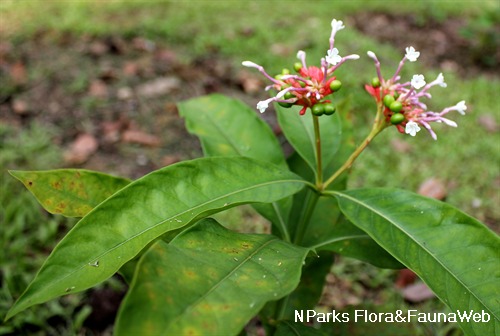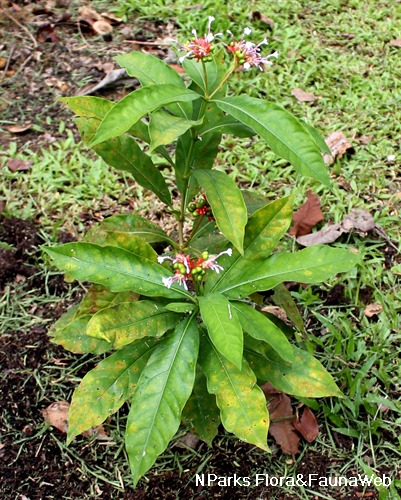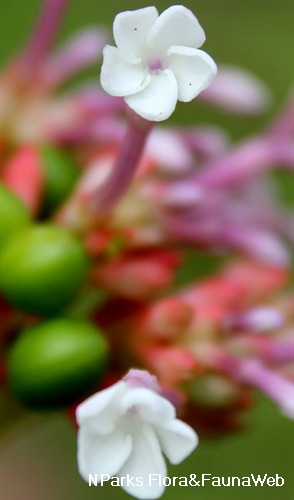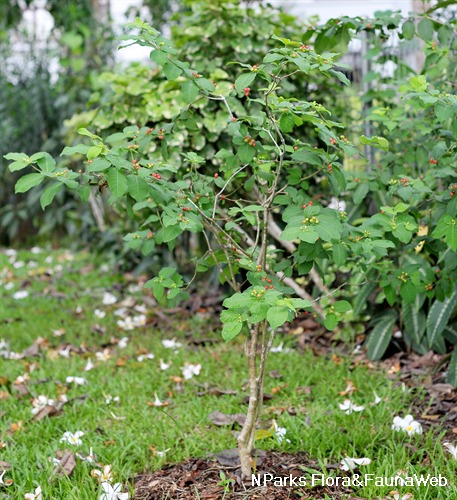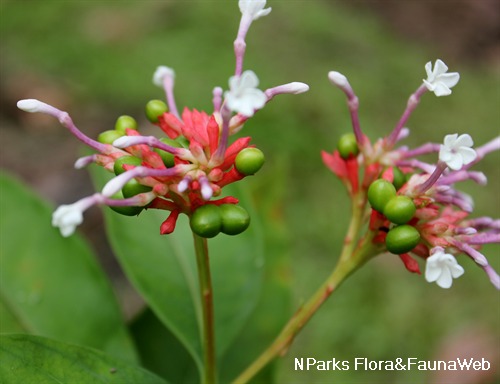
Back
Rauvolfia serpentina (L.) Benth. ex Kurz
| Family Name: | Apocynaceae |
| Common Name: | Indian Snakeroot, Serpentine Roots, 印度蛇根草, 蛇根木 |
Name
Classifications and Characteristics
| Plant Division | Angiosperms (Flowering Seed Plants) (Dicotyledon) |
|---|---|
| Plant Growth Form | Shrub |
| Lifespan (in Singapore) | Perennial |
| Mode of Nutrition | Autotrophic |
| Maximum Height | 60 cm |
Biogeography
| Native Distribution | India, Indonesia, Malaysia, Myanmar, Sri Lanka, Thailand and China |
|---|---|
| Native Habitat | Terrestrial |
| Preferred Climate Zone | Tropical, Sub-Tropical / Monsoonal |
Description and Ethnobotany
| Roots | Tuberous with pale brown cork. |
|---|---|
| Foliage | Leaves are large, in whorls of three, grouped near stem apex, bright green above and pale green beneath. |
| Stems | Usually unbranched, slender, straw colored. |
| Flowers | In irregular corymbose cymes with red pedicels and calyx, white corolla, often tinged with violet. |
| Fruit | The fruits are Drupe, small and shiny, oval, fleshy, turn purple black when ripe. |
| Habitat | Moist forests shady places near rain-forest. |
| Ethnobotanical Uses | Medicinal: The plant has been used for centuries for the relief of various central nervous system disorders, both psychic and motor. The roots are used as a sedative and in the treatment of hypertension. The bark, leaves and roots are used against snake and scorpion poisoningThe juice of the leaves has been used as a remedy for opacity of the cornea. Mixed with other plant extracts, they have been used in the treatment of cholera, colic and fever. Its medicinal value has been accepted by the allopathic system. Side effects of reserpine are usually transient and quickly disappear on reducing the dosage or discontinuing treatment. Side effect: Use of Rauvolfia serpentina may cause numerous adverse reactions. Women who are pregnant/plan pregnancy in the near future should not ingest Rauvolfia plants. They may also be harmful for people with any chronic disease of the gastrointestinal tract. |
Landscaping Features
| Desirable Plant Features | Ornamental Flowers |
|---|
Plant Care and Propagation
| Light Preference | Full Sun |
|---|---|
| Water Preference | Moderate Water |
| Rootzone Tolerance | Moist Soils, Well-Drained Soils |
| Propagation Method | Seed, Stem Cutting (Hardwood), Root Cutting |
Foliar
| Foliage Retention | Evergreen |
|---|---|
| Mature Foliage Colour(s) | Green |
| Mature Foliage Texture(s) | Smooth |
| Foliar Type | Simple / Unifoliate |
| Foliar Arrangement Along Stem | Whorled |
| Foliar Attachment to Stem | Petiolate |
| Foliar Shape(s) | Non-Palm Foliage (Obovate, Elliptical) |
| Foliar Margin | Entire |
| Foliar Apex - Tip | Acuminate |
| Foliar Base | Cuneate |
| Leaf Area Index (LAI) for Green Plot Ratio | 4.5 (Shrub & Groundcover - Dicot) |
Floral (Angiosperm)
| Flower Colour(s) | Pink, White |
|---|---|
| Flower Location | Axillary, Terminal |
| Inflorescence Type | Cyme |
Fruit, Seed and Spore
| Mature Fruit Colour(s) | Black, Purple |
|---|---|
| Mature Fruit Texture(s) | Smooth, Glossy / Shiny |
Image Repository
Others
| Master ID | 31497 |
|---|---|
| Species ID | 5894 |
| Flora Disclaimer | The information in this website has been compiled from reliable sources, such as reference works on medicinal plants. It is not a substitute for medical advice or treatment and NParks does not purport to provide any medical advice. Readers should always consult his/her physician before using or consuming a plant for medicinal purposes. |

